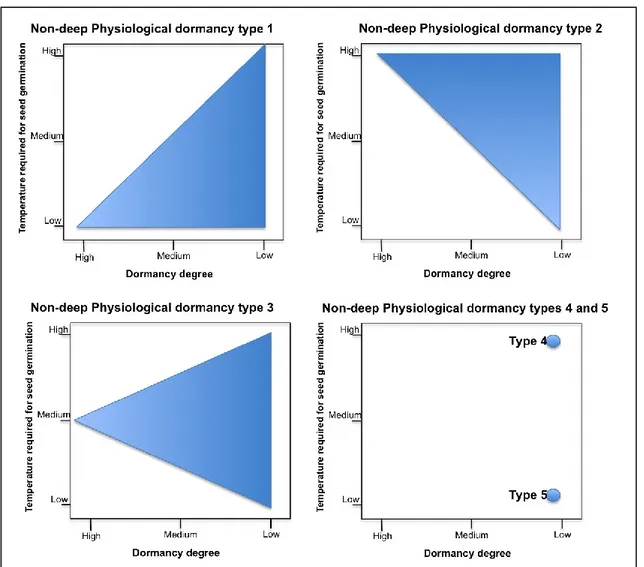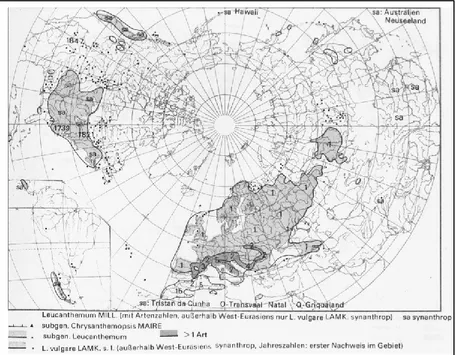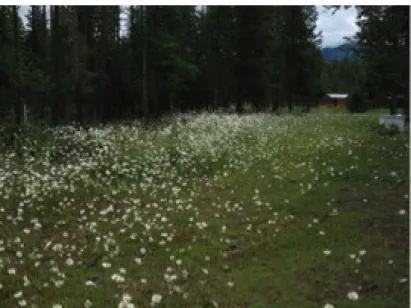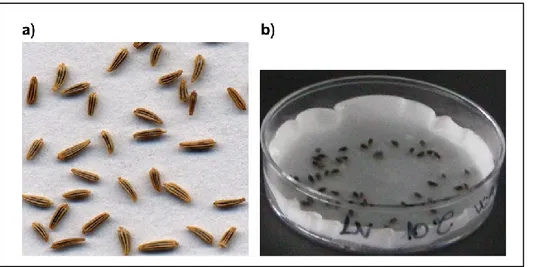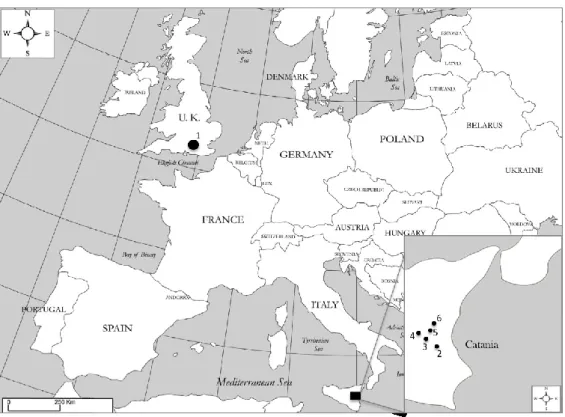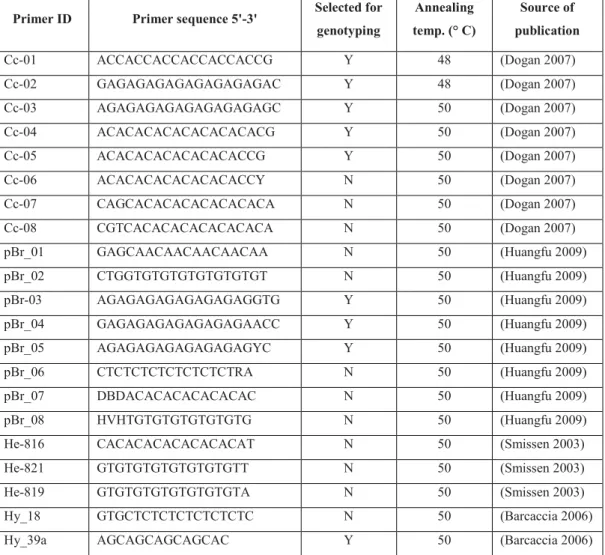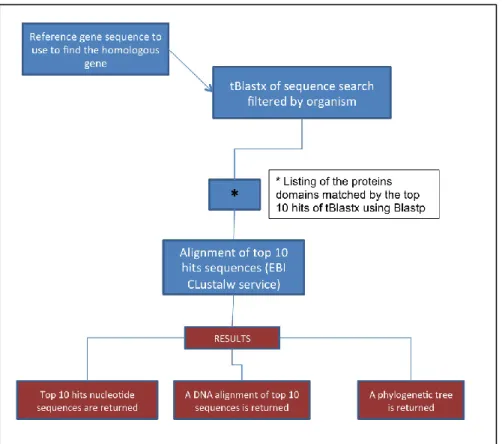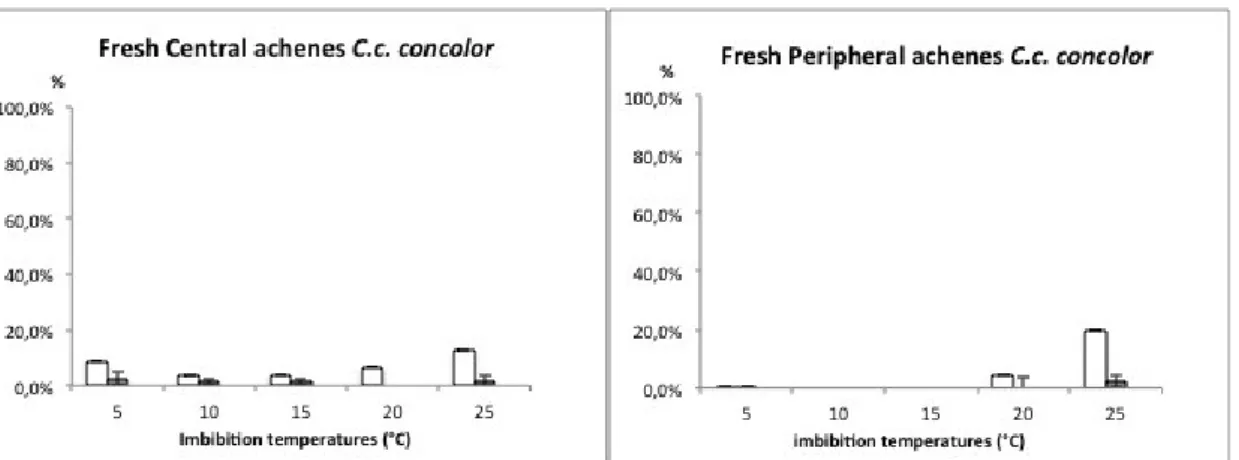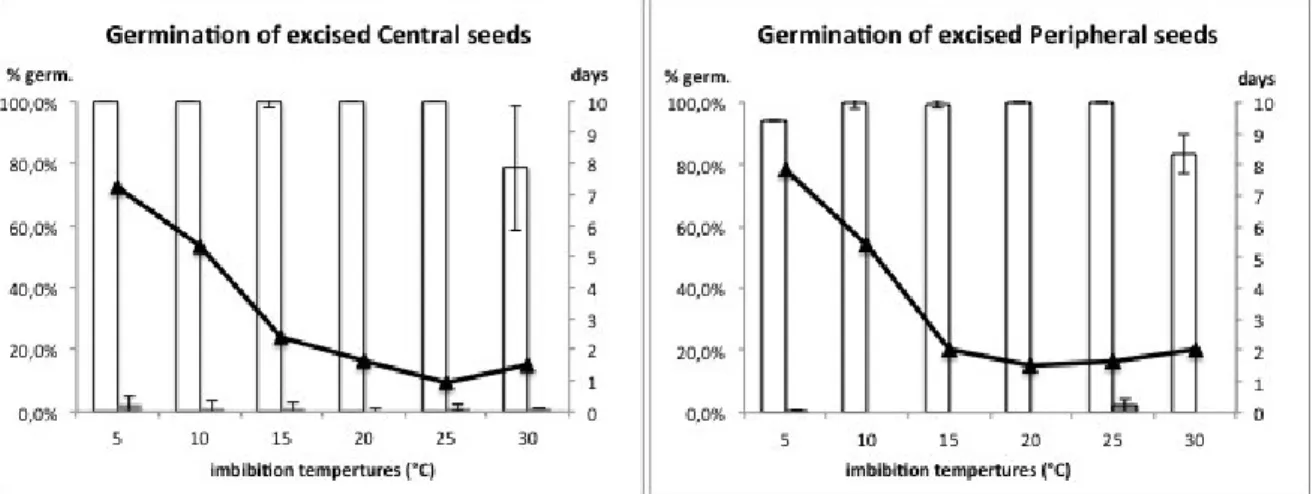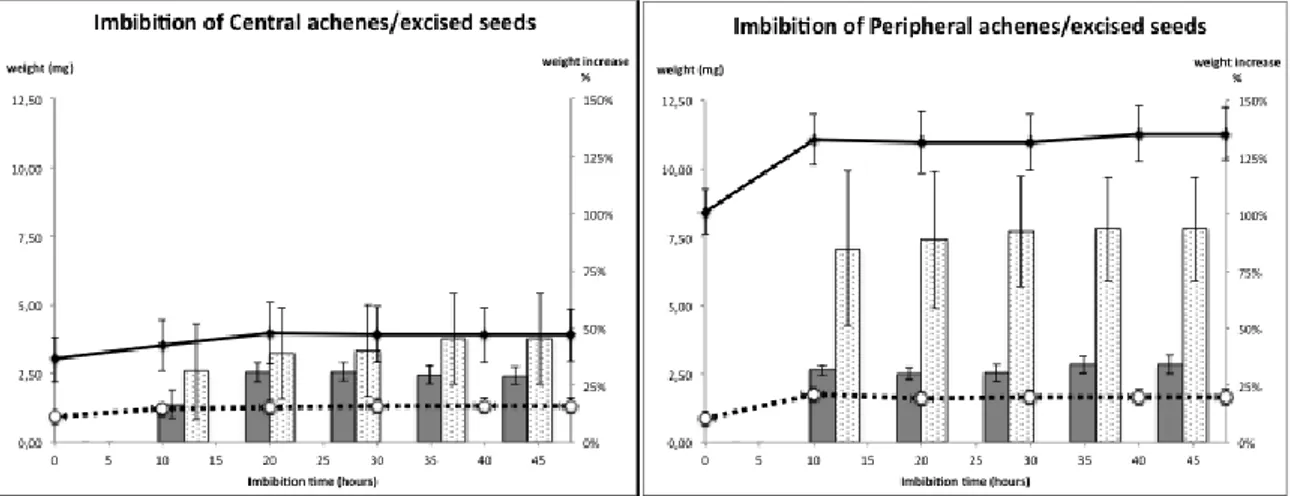UNIVERSITA' DEGLI STUDI DI CATANIA
Dipartimento di Scienze Biologiche, Geologiche e Ambientali
D
OTTORATO DI
R
ICERCA IN
B
IOLOGIA
E
VOLUZIONISTICA E DELL
‟A
MBIENTE
Coordinatore: Prof. Salvatore Saccone
G
IUSEPPE
D
IEGO
P
UGLIA
Meccanismi fisiologico-molecolari di
germinazione in specie spontanee
_____________________________
Tesi di dottorato
UNIVERSITA' DEGLI STUDI DI CATANIA
Dipartimento di Scienze Biologiche, Geologiche e Ambientali
D
OTTORATO DI
R
ICERCA IN
B
IOLOGIA
E
VOLUZIONISTICA E DELL
‟A
MBIENTE
Coordinatore: Prof. Salvatore Saccone
G
IUSEPPE
D
IEGO
P
UGLIA
Physiological and molecular
mechanisms of seed germination in
weed species
_____________________________
Ph.D. thesis
_____________________________
Tutor: Prof. Pietro Pavone
Co-Tutor: Dr. Peter Toorop
XXVI cycle
AA.AA. 2010÷2013
Abstract
Seed dormancy provides a mechanism for plants to delay germination until conditions are optimal for survival of the next generation. Knowledge of dormancy release and dormancy induction requirements is important to increase our understanding about the entire process. Furthermore, assess the association between gene expression patterns and physiological phase in dormancy is a major goal to allow a positive definition of this condition.
In Chrysanthemum coronarium var. concolor and var. discolor, anatomical and germination analyses showed that non-deep physiological dormancy (PD) is the more plausible type of dormancy for both of them. The genetic composition of Chrysanthemum coronarium varieties was characterized using Inter Simple Sequence Repeat (ISSR) PCR together with a DNA-Barcoding approach.
Seed priming treatments were used in a non-dormant species, Leucanthemum vulgare, to induct secondary dormancy at specific temperature range and a long-priming treatment was used for its release. Fluridone and giberellic acid were tested to investigate the metabolic pathway involved in the onset of secondary dormancy and in its maintenance. Five probable housekeeping genes, useful as reference genes for quantitative PCR (qPCR) analysis in seed tissue, were identified in Chrysanthemum coronarium and in Leucanthemum vulgare, isolated and confirmed with comparative analysis with homologous genes in model species. One radicle-protrusion associated gene, EXP (Expansin), was identified in the two species, isolated and confirmed. Three dormancy-associated genes, DOG1 (Delay Of Germination 1), FLC (Flowering Locus C), HUB2 (Histone Mono-Ubiquitination 2) were identified in Chrysanthemum coronarium and in Leucanthemum vulgare.
Table of contents
Introduction ... 1
Seed germination ... 1
Water imbibition and metabolism reactivation ... 1
Protein synthesis ... 2 Radicle extension ... 3 Seed dormancy ... 5 Physiological dormancy (PD) ... 6 PD deep ... 6 PD intermediate ... 7 PD non-deep ... 7
Physical restriction and embryo growth potential ... 8
Morphological dormancy (MD) ... 9
Morphophysiological dormancy (MPD) ... 9
Physical dormancy (PY) ... 9
Combinational dormancy (PY+PD) ... 10
Molecular aspects of seed dormancy ... 11
Dormancy release ... 12 Dry after-ripening ... 12 Warming ... 13 Seed priming ... 14 Hydropriming ... 14 Osmopriming ... 15 Chrysanthemum coronarium ... 17
Species description and distribution ... 17
Heterocarpy and dormancy in Asteraceae ... 18
Seed germination ... 19
Leucanthemum vulgare ... 20
Species description and distribution ... 20
Seed germination ... 22
Varietal genotyping ... 24
Aim of the thesis ... 27
Materials and Methods ... 29
Study sampling ... 29
Germination experiments ... 30
Seed excision ... 31
Water uptake ... 31
Anatomical analyses of pericarp tissue ... 31
Germination in dark ... 31
Cold stratification ... 32
Data analysis ... 37
Identification and isolation of reference and dormancy associated genes in C. coronarium and L. vulgare ... 37
Reference genes ... 37
Dormancy associated genes ... 38
DNA extraction ... 39
RNA extraction ... 39
cDNA first strand synthesis ... 40
PCR products cloning ... 40
Sequences analysis ... 41
Results ... 43
Physiology of germination of Chrysanthemum coronarium ... 43
Germination behaviour ... 43
Seed excision... 44
Water uptake ... 45
Anatomical analyses of pericarp tissue ... 45
Germination in dark ... 48
Cold stratification ... 49
Dry storage ... 51
Dry after ripening ... 52
Wet warm stratification ... 54
ABA synthesis ... 59
Genotyping of Chrysanthemum coronarium concolor and discolor varieties ... 60
DNA extraction ... 60
ISSR analyses ... 62
Sequencing of rbcL gene ... 62
Physiology of germination in Leucanthemum vulgare ... 63
Germination behaviour ... 63
Seed osmo-priming ... 63
Hydro-priming ... 65
ABA synthesis ... 66
Isolations of dormancy genetic markers in Leucanthemum vulgare and Chrysanthemum coronarium ... 69
Genes selection ... 69
DNA extraction ... 71
RNA extraction ... 71
PCR products cloning with TA-Vector ... 72
Sequences analyses ... 77
Phosphoglycerate kinase (PGK) gene ... 77
18s gene: ... 78 UBC 21 gene ... 79 UBC 8-28 gene ... 80 UBC 9-10 gene ... 81 UBC sequences: ... 82 Expansin gene: ... 83 Discussion ... 85
Chrysanthemum coronarium germination physiology ... 85
Chrysanthemum coronarium varietal genotyping ... 86
Leucanthemum vulgare germination physiology... 87
Cloning of reference and dormancy associated genes: ... 88
Conclusions ... 89
Introduction
Seed germination
Seeds are the mobile phase of the plant‘s life cycle, vegetative development is suspended as seeds transport the plant‘s genetic complement through space and time. Seeds are mostly shed from the mother plant in a dry state in which the seed tissues (embryo, covering layers) are preserved at low water content. Seed germination commences with the uptake of water by the dry seed, followed by embryo expansion growth (Hilhorst 2010). Under favourable conditions rapid expansion growth of the embryo culminates in rupture of the covering layers and emergence of the radicle.
Water imbibition and metabolism reactivation
Uptake of water by a mature dry seed is triphasic Figure 1, with a rapid initial uptake (phase I) followed by a plateau phase (phase II). A further increase in water uptake occurs only after germination is completed, as the embryonic axes elongate. Because dormant seeds do not complete germination, they cannot enter phase III. The influx of water into the cells of dry seeds during phase I results in temporary structural perturbations, particularly to membranes, which lead to an immediate and rapid leakage of solutes and low molecular weight metabolites into the surrounding imbibition solution (J. D. Bewley 1997) (Crowe 1992).
Upon imbibition, the quiescent dry seed rapidly resumes metabolic activity. The structures and enzymes necessary for this initial resumption of metabolic activity are generally assumed to be present within the dry seed, having survived, at least partially intact. Reintroduction of water during imbibition is sufficient for metabolic activities to resume, with turnover or replacement of components occurring over several hours as full metabolic status is achieved Figure 1. One of the first changes upon imbibition is the resumption of
_____________________________________________________________________Introduction
2
Figure 1 Time course of major events associated with germination and subsequent post-germination growth
Protein synthesis
All of the components necessary for the resumption of protein synthesis upon imbibition are present within the cells of mature dry embryos, although polysomes are absent. However, within minutes of rehydration there is a decline in the number of single ribosomes as they become recruited into polysomal protein-synthesizing complexes. Initial protein synthesis is dependent on extant ribosomes, but newly synthesized ribosomes are produced and used within hours of initial polysome assembly (Dommes 1990). Preformed mRNAs are also present within the dry embryo.
Some of these are residual messages associated with previous developmental processes (Comai 1990) (Lane 1991) and may be used transiently during early germination Figure 1. Messages encoding proteins that are important during seed maturation and drying, such as late embryogenesis abundant (LEA) proteins, are likely to be degraded rapidly upon imbibition (Jiang 1994) (Han 1996). Conversely, those encoding proteins required during early germination (e.g., ribosomal protein messages) are replaced by identical messages at later times, with protein synthesis becoming more dependent on the new transcripts with time (Beltran-Petia 1995) (see Figure 1).
New mRNAs are transcribed as germination proceeds. The majority of these are likely to encode proteins essential for the support of normal cellular metabolism, that is, ―growth maintenance‖ reactions that are not restricted to germination (J. D. Bewley 1990). Nevertheless, some changes in embryo mRNA populations and synthesized proteins do occur during germination of several species of monocots (e.g., maize; (Sánchez-Martinez 1986), dicots, e.g. peas (Lalonde 1986), and conifers, e.g. loblolly pine (Mullen 1996)).
Radicle extension
With few exceptions, radicle extension through the structures surrounding the embryo is the event that terminates germination and marks the commencement of seedling growth. This extension may or may not be accompanied by cell division. Two discrete phases of DNA synthesis occur in the radicle cells after imbibition Figure 1. The first takes place soon after imbibition and probably involves the repair of DNA damaged during maturation drying and rehydration as well as the synthesis of mitochondrial DNA. DNA synthesis associated with post-germinative cell division accounts for the second phase Figure 1 (Zlatanova 1987) (Osborne 1994).
Extension of the radicle is a turgor-driven process that requires yielding of walls in those cells of the embryonic root axis that lie between the root cap and the base of the hypocotyl. There are three possible reasons for the commencement of radicle growth. One possibility is that late during germination, the osmotic potential (ψπ) of the radicle cells
becomes more negative because of the accumulation of solutes, perhaps as a result of the hydrolysis of polymeric reserves present within the radicle cells themselves. The decrease in ψπ would lead to increased water uptake, and the resulting increase in turgor would drive
cell extension. A second possibility is that extensibility of the radicle cell walls allows for their elongation. Whether the mechanisms by which cells of the radicle become more extensible differs from those in other tissues is not known. Cell wall loosening may result from the cleavage and re-joining of xyloglucan molecules that tether adjacent cellulose
_____________________________________________________________________Introduction
4 cucumber hypocotyls (McQueen-Mason 1995) (Cosgrove 1997) and in the coleoptile elongation in rice cultivars (Magneschi 2009).
However, neither of these cell wall-loosening proteins has been reported in germinating seeds. Moreover, both XET and expansin activities in seedlings appear to be enhanced by auxin, which is generally regarded as ineffective in promoting seed germination, and XET activity in maize seedling roots is also enhanced by abscisic acid (ABA), a potent inhibitor of embryo radicle elongation! A third possibility is that the seed tissues surrounding the radicle tip weaken, thus allowing the tip to elongate. Because there are no changes in cell ψπ before radicle growth commences, it is axiomatic that the turgor potential (ψρ) of the
radicle cells is sufficient to drive their elongation if there is little or no restraint exerted by the surrounding structures.
In many germinating seeds, including those of rape, the testa splits during imbibition, and it is only the rigidity of the radicle cell walls that restrains growth (Schopfer 1985) (Figure 2). As the walls yield during the initial stages of radicle elongation, there is a decline in cell ψρ. Conversely, in other seeds, ψρ alone is insufficient
to drive wall extension, and there is a severe constraint on radicle cell growth imposed by the surrounding structures. In lettuce, tobacco, and tomato seeds, the endosperm is the constraining structure, whereas in muskmelon it is the perisperm. A reduction in the resistance of these enclosing structures is necessary for germination to be completed. Measurements have revealed a decline in the mechanical resistance of the structures covering the embryo root cap at the time of radicle emergence in the endosperm of pepper seeds (Watkins 1983) and in endosperm cap in tomato (Toorop 2000). This decline in resistance is likely to be achieved by cell wall hydrolases, such as hemicellulases, produced within and secreted by the endosperm itself.
Figure 2 Seed structures, sizes and phylogenetic relationships of model and crop species. (a) Generalised structure of an angiosperm (eudicot) seed with EMBRYO and ENDOSPERM as the two important seed components. The direction of embryo growth (arrow „Growth potential‟) that results in germination (rupture of the endosperm) and repressive function of endosperm (block „restrain‟) are shown. (b) Phylogenetic relationship and seed size comparison for Arabidopsis, Lepidium, Medicago, and tomato.
Seed dormancy
Germination timing is a plant trait with the highest selection pressure by the environment and has, during seed evolution, led to a connected second key trait: seed dormancy. This can be defined as the (temporary) incapacity of a viable imbibed seed to germinate under favourable conditions.
Virtually all of the cellular and metabolic events that are known to occur before the completion of germination of non-dormant seeds also occur in imbibed dormant seeds; indeed, the metabolic activities of the latter are frequently only subtly different from those of the former. Hence, a dormant seed may achieve virtually all of the metabolic steps required to complete germination, yet for some unknown reason, the embryonic axis (i.e., the radicle) fails to elongate (J. D. Bewley 1997).
Seed dormancy could be considered simply as a block to the completion of germination of an intact viable seed under favourable conditions. In the review 'Seed dormancy and the control of germination' (W. E.-M. Finch-Savage 2006) they present an integrated view
_____________________________________________________________________Introduction
6 becomes non-dormant. On the other hand, a completely non-dormant seed has the capacity to germinate over the widest range of normal physical environmental factors possible for the genotype. For the species survival, the role of seed dormancy is to spread germination across time, but in synchrony with the seasons to avoid unfavourable conditions for plant establishment (C. C. Baskin 1998) (Rodríguez 2011).
Seed physiology literature discriminates two types of dormancy focussing on the timing of the onset respect to the developmental stage of seed: primary dormancy (PD) refers to the type of dormancy that occurs prior to dispersal as part of the seed developmental program, whereas secondary dormancy (SD) refers to the acquisition of dormancy in a mature seed after imbibition as a result of the lack of proper conditions for germination (Amen 1968) (Hilhorst 2010).
Nikolaeva (Nikolaeva 1969) devised a dormancy classification system reflecting that dormancy is determined by both morphological and physiological properties of the seed. Based on this scheme, C. Baskin and J. Baskin (J. M. Baskin 1998) have proposed a comprehensive classification system which includes five classes of seed dormancy. The system is hierarchical with these five classes further divided into levels and types Baskin and Baskin (J. M. Baskin 2004).
Physiological dormancy (PD)
PD (dormancy class A according to Baskin and Baskin, 2004) is the most abundant form and is found in seeds of gymnosperms and all major angiosperm clades. It is the most prevalent dormancy form in temperate seed banks and the most abundant dormancy class ―in the field‖. PD is also the major form of dormancy in most seed model species ―in the lab‖, including Arabidopsis thaliana, Helianthus annuus, Lactuca sativa, Lycopersicon esculentum, Nicotiana spp., Avena fatua, and several cereals.
PD deep
Embryos excised from PD-deep seeds either do not grow or will produce abnormal seedlings. GA treatment does not break their dormancy. Ca. 3-4 months of cold (subtype a) or warm (subtype b) stratification are required before germination can take place. Examples: Acer platanoides (PD deep subtype a) Aceraceae (W. E. Finch-Savage 1998); Leptecophylla tameiameiae (PD deep subtype b) (C. C. Baskin 2005) (Blumenthal 1986).
PD intermediate
Embryos excised from PD-intermediate seeds produce normal seedlings. GA promotes germination in some (but not all) species. Seeds require 2-3 months of cold stratification. Dry storage (after-ripening) can shorten the cold stratification period. Example: Acer pseudoplatanus (PD intermediate), Aceraceae (W. E. Finch-Savage 1998).
PD non-deep
The great majority of seeds have non-deep PD. Embryos excised from these seeds produce normal seedlings. GA treatment can break this dormancy and depending on species dormancy can also be broken by scarification, after-ripening in dry storage, and cold (0-10° C) or warm (>15° C) stratification. Based on patterns of change in physiological responses to temperature five types of non-deep PD can be distinguished (see Figure 3). Most seeds belong to type 1 or 2, in which the temperature range at which seed germination can occur increases gradually during the progression of non-deep dormancy release from low to higher (type 1, e.g. Arabidopsis thaliana) or from high to lower temperature (type 2, e.g. Helianthus annuus). In addition, the sensitivity of the seeds to light and GA increases as non-deep PD is progressively released. The molecular mechanisms of Arabidopsis seed dormancy cycling have been investigated by transcriptome analyses (Cadman 2006).
_____________________________________________________________________Introduction
8
Figure 3 Five types of non-deep physiological seed dormancy (PD) according to Baskin and Baskin (2004). Type 1: Temperature range for germination increases during dormancy release as a continuum from low to high, example: Arabidopsis thaliana; Type 2: Temperature range for germination increases during dormancy release as a continuum from high to low, example: Helianthus annuus; Type 3: temperature range for germination increases during dormancy release as a continuum from medium to high and low, example: Aster ptarmacoides. Type 4 and 5: No temperature and dormancy continuum, non-dormant seeds germinate only at high temperature (Type 4), example: Callicarpa
americana or low temperature (Type 5), example: Gentianella quinquefolia.
Physical restriction and embryo growth potential
Within the non-deep physiological dormancy the removal or disruption of structures that covers the embryo, such as endosperm, seed coat, fruits coats, could results in germination. Embryo or seed covers could, indeed, exert an inhibitory effect of mechanically restricting embryo or seed growth.
The force required to break seed coats ranges from 9.9MPa in Pancratium marithimum to 133.2MPa in Iris lorteti (Blumenthal 1986). Thus germination could be prevented because embryos lack a sufficient growth potential to break open seed coat or other structures (Khan 1982). Depending on the species, cold stratification (Carpita 1983), giberellic acid (J. M. Baskin 1971), incubation temperatures (Juntilla 1973), light (Scheibe 1965), or
darkness (S. Chen 1968) may increase the growth potential of the embryo enough for the radicle to push through the seed coat and thus for seed to germinate.
Scarification of positively photoblastic seeds of cucumber and sunflower resulted in about 50% increase of germination in light at 22° C in 0.45M (1.13MPa) and 0.3M (0.75MPa) mannitol solutions, respectively, indicating that removal of the mechanical constraint allowed seeds to germinate at an increased osmotic potential (McDonough 1967). In tomato the endosperm cap weakening is a biphasic process correlated with endo-β-mannase activity for the first phase and controlled by ABA in the latter one (Toorop 2000). Morphological dormancy (MD)
MD (dormancy class B according to Baskin and Baskin, 2004) is evident in seeds with embryos that are underdeveloped (in terms of size), but differentiated (e.g. into cotyledons and hypocotyl-radical). These embryos are not (physiologically) dormant, but simply need time to grow and germinate. This group does not include seeds with undifferentiated embryos. Example: Apium graveolens (Apiaceae).
Morphophysiological dormancy (MPD)
MPD (dormancy class C according to Baskin and Baskin, 2004) is also evident in seeds with underdeveloped (in terms of size) embryos, but in addition they have a physiological component to their dormancy. These seeds therefore require a dormancy-breaking treatment, e.g. a defined combination of warm and/or cold stratification which in some cases can be replaced by GA application. In MPD-seeds embryo growth/emergence requires a considerably longer period of time than in MD-seeds. Seeds with undifferentiated embryos like the Orchidaceae also have a morphological and a physiological component of dormancy, but they are not considered in this classification scheme (J. M. Baskin 2004).
_____________________________________________________________________Introduction
10 movement (often associated with hard seed coat). Seeds will remain dormant until some factor(s) render the covering layer(s) permeable to water. In nature, these factors include high temperatures, widely fluctuating temperatures, fire, drying, freezing/thawing and passage through the digestive tracts of animals. In seed technology, mechanical or chemical scarification can break PY dormancy. Once PY is broken, i.e. the seed or fruit coat becomes permeable to water, the seeds can germinate over a wide range of ambient conditions. Unlike PD-seeds, which may re-enter (secondary) dormancy after primary dormancy is broken, once the coat of PY-seeds becomes permeable it generally cannot revert to complete impermeability. Thus, the timing of dormancy break in nature is a more critical event in the life cycle of plants with PY, than it is in those with PD. The mechanism for PY-break must therefore be fine-tuned to the environment.
Figure 4 Testa (seed coat) structure of a typical legume seed (Fabaceae). Water impermeability is due to a palisade layer of macrosclereids (Malphighian cells) in the exotesta.
Combinational dormancy (PY+PD)
Combinational dormancy, PY+PD (dormancy class E according to Baskin and Baskin 2004), is evident in seeds with water-impermeable coats (PY) combined with physiological embryo dormancy (PD non-deep). Within the Ancardiaceae the genus Rhus includes species with PY+PD- dormancy (e.g. Rhus aromatica) and species with only PY-dormancy (e.g. Rhus glabra). Embryos of freshly harvested mature PY+PD-dormant seeds of winter annuals, e.g. Geranium spp. (Geraniaceae, Rosids) and Trifolium spp. (Fabaceae, Rosids), have some conditional dormancy (PD non-deep). This PD is released during after-ripening storage, even of the seed coat remains water impermeable (PY). Embryos of
PY+PD-dormant Ceanothus spp. (Rhamnaceae, Rosids) are more deeply PY+PD-dormant (but still PD non-deep). In this case PY is released first and the subsequent water uptake during imbibition is followed by the release of the embryo dormancy (PD non-deep) during a few weeks of cold stratification. Thus, release from PY and PD of PY+PD-dormant seeds seems to be by independent events and the timely order can be species-specific.
Molecular aspects of seed dormancy
Despite the obvious importance of dormancy cycling in the natural environment (J. M. Baskin 1998), very little is known about its regulation at a molecular level. In contrast, a great deal is known about mechanisms that influence dormancy loss in short-term laboratory experiments (W. E.-M. Finch-Savage 2006), (Finkelstein 2008), (Holdsworth 2008) that inform us about dormancy in the context of crop seeds.
Recent -omics studies of the transcriptome (Cadman 2006) (W. E. Finch-Savage 2007) and proteome (Gallardo 2002) (Rajjou 2004) show that seeds change and remain responsive at a molecular level in both the imbibed and the dry state. A dynamic balance of the hormones abscisic acid (ABA) and gibberellic acid (GA), resulting from both synthesis and catabolism, is thought to be central to dormancy and the control of germination completion (radical emergence through the seed coat) (W. E.-M. Finch-Savage 2006). Regulation of dormancy status results from the response to this balance through hormone-signaling networks that influence sensitivity to ABA and GA. The influence of other hormones, such as ethylene (Linkies 2009), can be significant, but in general their influence operates through the ABA/GA balance.
Recently, the seed transcriptome, and in particular those genes involved in the ABA/GA balance, were shown to be sensitive to maturation temperature, which is important in setting dormancy status before shedding from the mother plant (Kendall 2011). Genetic approaches have led to the identification of specific loci correlated with altered dormancy, and -omics approaches in many species have identified numerous transcripts and proteins
_____________________________________________________________________Introduction
12 Dormancy release
In most angiosperm species, primary dormancy is gradually lost after the seed is ready for dispersal (in wild species) or harvest during a post-maturation or after-ripening period. This process takes place in seeds during dry storage or in buried seeds in the soil as well, although these different environmental conditions can have great impact on the rate at which dormancy is terminated. Release of primary dormancy occurs at different rates depending mainly on the genotype (Probert 2000), but time is needed in many species for their seeds to be able to germinate (although some hard-coated seeds depend absolutely on chemical or mechanical scarification). Even in species that depend on the presence of light for germination (like many Solanaceae), sensitivity to light also varies with time after seed dispersal, and seed germination eventually becomes light independent (Probert 2000). So, the time lapse required by a seed population to lose dormancy and be able to undergo rapid germination immediately after sowing is a character that varies greatly not only between species, but also between different genotypes (i.e., cultivars, inbred lines, etc.) of the same species (Rodríguez 2011).
Dry after-ripening
During dry storage, seeds undergo physiological changes, which are often reflected in a decline in the level of innate dormancy. Accompanying these dry after-ripening changes, germination requirements usually become less specific (Probert 2000).
After-ripening, i.e. a period of usually several months of dry storage at room temperature of freshly harvested, mature seeds, is a common method used to release dormancy and to promote germination (J. D. Bewley 1997) (W. E.-M. Finch-Savage 2006) (Kucera 2005) (Leubner-Metzger 2003). Seed after-ripening can be characterized by (Leubner-Metzger 2005):
A widening of the temperature range for germination.
A decrease in ABA level and sensitivity and an increase in GA sensitivity or loss of GA requirement.
A loss of light-requirement for germination in seeds that do not germinate in darkness.
An increase in seed sensitivity to light in seeds that do not germinate even with light.
An increase of germination velocity. During tobacco seed after-ripening this is evident by a promotion of testa rupture and endosperm rupture.
The parameters that determine seed after-ripening are moisture and oil contents, seed covering structures, and temperature (Manz 2005).
However, for species adapted to regions of seasonal drought and dry soils – for example, winter annuals – physiological changes recorded during dry storage reflect a natural mechanism, which governs the timing of germination in the wild. When seeds of winter annuals are in a state of conditional dormancy, shortly after dispersal, germination is characteristically restricted to a narrow range of low temperatures (P. A. Thompson 1970) (J. M. Baskin 1971) (J. M. Baskin 1978) (Pemadasa 1975).
Warming
In contrast to the immense literature on low-temperature effects, there have been far fewer reports of the effect of warm temperatures on changes in germination behaviour. However, it is clear that, like chilling, warm temperature pre-incubation of imbibed seeds can both release and induce dormancy (Probert 2000). In summer annuals in general, low winter temperatures release dormancy, whereas high summer temperatures induce dormancy (J. M. Baskin 1977) (J. M. Baskin 1987), while in winter annuals the reverse is true (J. M. Baskin 1978) (J. M. Baskin 1978). In a study on germination in desert perennial shrub species from South Africa, Gutterman (Gutterman 1990) demonstrated that the effect of pre-incubating seeds at 45° C for 24 h depended on whether plants originated from areas receiving winter or summer rain. In the former, germination was adversely affected, whereas, in the latter, germination was stimulated by high-temperature treatment.
_____________________________________________________________________Introduction
14
Seed priming
Seed priming is the induction of a particular physiological state in plants by the treatment of natural and synthetic compounds to the seeds before germination (Jisha 2013). For priming the seeds, seeds are partially hydrated until the germination process begins, but radical emergence does not occur (Bradford 1986).
Seed priming is widely used to synchronize the germination of individual seeds (Taylor 1990). Improved seed invigoration techniques are known to reduce emergence time, accomplish uniform emergence, and give better crop stand in many horticultural and field crops (Ashraf 2005). Seed-priming technology has twofold benefits: enhanced, rapid and uniform emergence, with high vigor and better yields in vegetables and floriculture (Bruggink 1999) and some field crops (S. M. Basra 2005) (Kaur, Seed priming increases crop yield possibly by modulating enzymes of sucrose metabolism in chickpea. 2005). According to McDonald et. al. (McDonald 2000), primed seeds acquire the potential to rapidly imbibe and revive the seed metabolism thus enhancing the germination rate.
Primed seeds usually exhibit an increased germination rate, greater germination uniformity, and at times, greater total germination percentage (S. M. Basra 2005). The various approaches include hydropriming, osmopriming, chemical priming, hormonal priming, biological priming, redox priming, solid matrix priming, etc.
Hydropriming
Hydropriming has been reported to be a simple, economical and a safe technique for increasing the capacity of seeds towards osmotic adjustment, enhancing seedling establishment and crop production under stressed conditions (Kaur 2002). In this priming method, the seeds are immersed in sterilized distilled water kept at appropriate temperature and the duration of hydropriming is determined by controlling seed imbibition during germination (Kaya 2006). It is absolutely necessary to dry the seeds after soaking, as storing of improperly dried seeds will do more harm than good (Thomas 2000). After soaking, seeds were re-dried to their original weight with forced air under shade (Bennett 1987). In hydropriming, the advantageous fact is the enhancement of physiological and biochemical events taking place in seeds even when the germination is suspended by low osmotic potential and negligible matric potential of the imbibing medium (S. M. Basra 2003). Moreover, the protoplasm of hydroprimed seeds/plants is found to have a lower viscosity and exhibit higher permeability to water and nutrients and also hold water against
dehydrating forces (Thomas 2000). Increase in the seedling growth correlated with higher water uptake by primed seeds is the predominant feature in the case of hydropriming (Yagmur M. 2008). Hydropriming was found to be the most effective method for improving seed germination of onion, especially when the seeds were hydrated for 96 h compared to 48 h (Caseiro 2004). Priming decreased the temperature optimum and ceiling temperature for germination and also helped in advancing the germination time and did not decrease the final percentage emergence (W. E. Finch-Savage 2004).
Osmopriming
Osmoconditioning or osmopriming is the soaking of seeds in aerated, low-water-potential solutions. Osmopriming essentially exposes seeds to low external water potential to restrict the rate and extent of imbibition. The process of osmopriming is akin to a prolonged early imbibition of seeds that sets in motion a gradual progression of various pre-germinative metabolic activities. Thus, it is helpful to use osmopriming as a model to study the transition of seeds from a dry and physiologically quiescent to a hydrated and physiologically active state (K. A. Chen 2011).
A variety of chemicals are used to create low-waterpotential solutions. Polyethylene glycol (PEG) is more commonly used as water potential lowering agent because of its nontoxic nature and large molecular size, which lowers water potential without penetrating into the seeds during soaking (Thomas 2000). Jett et al. (Jett 1996) explained that, osmopriming in comparison with hydropriming can preserve plasma membrane structure and cause seeds to have better responses to germination traits because of controlled long hydration in seeds. In rice, the physiological changes produced by osmohardening enhanced the starch hydrolysis and made more sugars available for embryo growth, vigorous seedling production and later on improved allometric, kernel yield and quality attributes (Farooq 2006). Rouhi et al. (Rouhi 2011) suggested that different priming techniques (hydro and osmopriming) had a varying effects on germination on each of the four grass species
_____________________________________________________________________Introduction
16 behind priming is not completely known, it is speculated that sensitization was associated with accumulation of inactive signaling proteins in primed cells.
According to Nascimento and West (Nascimento 1998), the increase in germination percentage/seed vigour of primed seeds is due to reserve mobilization of food materials, activation and re-synthesis of some enzymes and also due to the increased DNA and RNA synthesis. Priming is also capable of repairing some of the damages due to seed erosion, which in turn results in increased vigour of primed seeds (Arif 2008). Seed priming affects the lag phase of seed germination and thus causes early DNA replication (Bray 1989).
In contrast to the immense literature on positive effects of priming, to date there are no reports recording a negatively interference of this treatment with germination in non-dormant seeds. In Amritphale et.al. (D. S. Amritphale 2000) a mechanism to induce dormancy is described which take into consideration a seed incubation in an osmoticum and the usage of far red light for 15 min; in this report the presumed induction system regarded the change in fluidity of cell membranes which are affected by a non-complete hydration.
Chrysanthemum coronarium
Species description and distribution
Chrysanthemum coronarium L. (family Asteraceae; tribe Anthemideae; genus Chrysanthemum) is an aromatic heterocarpic winter annual 20-60 cm high with a straight, hairless and branched trunk; leaves are light green, and deeply lobate. The chorological type is Steno-Mediterranean, see Figure 5 (Pignatti 1982) (Meusel 1965).
It is usually found as weed in diverse crops, along roadsides, on field margins and on abandoned fields Figure 6. Although essentially Mediterranean this species is nowadays naturalized far beyond their ‗native‘ range and since its abundance and persistence it was reported as invasive plant species (Cook 2011) (Schaefer 2011). In Sicily, his phytosociological association was described by earlier authors (Ferro 1980) (Brullo 1985) (Brullo 2001) (Ferro 2004).
Figure 5 Chysanthemum coronarium distribution according to (Meusel 1965).
Dumont d‘Urville described two varieties under Chrysanthemum coronarium: var. concolor d‘Urv., from the island of Malta, with yellow ray florets (―radio discoque luteis sola reperitur inter segetes insulae Melitae‖), and var. discolor d‘Urv., from the Aegean
_____________________________________________________________________Introduction
18
Mediterranean environment (E. C.-O. Cano 2012) (Cano-Ortiz 2007). In the thermo-Mediterranean belt the populations of both variants tend to appear separately with only occasional concurrences (E. C. Cano 2013).
Furthermore, a kariomorphological study (El-Twab 2008) on Chrysanthemum coronarium
varieties shown that, although the two varieties are both 2n = 18, as previously reported for Chrysanthemum coronarium (Bhattacharyya 1977) (Pavone 1981) (Razaq Z.A. 1988) (Nirmala A. 1986) (Vogt R. 1993) (Kaul M.L. 1995) (Strother 1997) (Carr 1999), they differ in the arrangement of two chromosomes (submedian-centromeric in discolor and median-centromeric in concolor).
In other studies, basing on the disposition of the intercostal glands, the colour of the ligules, and the size and wings of the cypselas of the flosculous flowers and their distribution, some researchers (E. C. Cano 2013) proposed to elevate the discolor var. to the rank of species as Glebionis discolor (d‘Urville 1822).
Therefore, a different approach based on molecular data is needed to further investigate the genetic grounds underneath the differentiation of the two varieties.
Figure 6 Co-occurence of Chrysanthemum coronarium concolor and discolor varieties in an abandoned field (for geographic reference see Table 1 sampling ID #5)
Heterocarpy and dormancy in Asteraceae
Imbert reported that heterocarpy/heterospermy is known to occur in 18 families of angiosperms, being most common in Asteraceae and Chenopodiaceae (E. Imbert 2002). Sixty-three and three-tenths percent of the species and 52.5% of the genera belong to the Asteraceae and 8.3 and 10%, respectively, to the Chenopodiaceae. In Asteraceae, fruit heteromorphism, i.e. the difference between central and peripheral achenes (McDonough,
Germination polymorphism in Grindelia squarrosa 1975), may be associated with a difference in germination behaviour, e.g. in Bidens, Senecio, Picris and Crepis (McEvoy 1984), (Rocha 1996), (E. E. Imbert 1999), (E. Imbert 2002), (Brändel 2004), (Brändel 2007). Central achenes are often less dormant and germinate over a wider range of temperatures, to higher percentages and at faster rates than peripheral ones (J. B. Baskin 1976), (Forsyth C. 1982), (Corkid 1991) (Rocha 1996) (Brändel 2007).
In seed heteromorphism the different fruit or seed morphs usually have differential ecological behaviour, mainly germination requirements and dispersal abilities. Peripheral achenes are frequently heavier, show more limited dispersal and have stricter requirements for germination (p.e. (E. E. Imbert 1999) (Clavijo 2001). In most of the heterocarpic Asteraceae central achenes germinate immediately when favourable conditions occur while peripheral achenes show delayed germination. Differential dispersal and germination allow spreading offspring in space and time, thus reducing density dependent effects such as sib competition, predation or pathogen attack (D. H. Janzen 1971) (Augspurger 1983) (Levin S. 1984) (Harms 2000). In addition, this different ecological behaviour leads to a risk-reducing or bet-hedging strategy that is advantageous in variable and unpredictable habitats such as Mediterranean biomes and highly disturbed, man-made habitats.
Discerning the differential ecology of achene morphs in heterocarpic weedy Asteraceae is of interest in weed population dynamics and basic weed biology studies which, in turn, can be useful in designing appropriate weed management practices (Bhowmik 1997).
Seed germination
Chrysanthemum coronarium emergence occurs in autumn and seedlings develop into overwinter rosettes that bolt in January and February. Flowering and fruiting start in late February or March and continue to early summer (F. M. Bastida 2004). Flowers consist of central hermaphrodite disc florets and marginal female ray florets with inferior ovaries (Cockshull 1984). These florets develop two morphologically distinct lignified fruit called
_____________________________________________________________________Introduction
20
Figure 7 a) One-winged central achene; b) Three-winged peripheral achene.
Both central and peripheral achenes show dormancy in a high proportion, especially peripheral achenes are more dormant than central ones (F. M. Bastida 2004).
Even thought some studies (M. P. Chiang 1994) (Vicente 2002) (Hwang 2008) (Banon 2009) (F. J. Bastida 2010) have been investigating the germination behaviour in Chrysanthemum coronarium, there is still a bit of uncertainty in defining precisely the type of dormancy of this species.
In a previous study (F. M. Bastida 2004) germination was tested against different conditions: temperature regimes, dark, with a pre-chilling treatment, in presence of GA3, of
nitrate solution, and finally excising seeds from achenes. From the highest germination frequency shown in response to seed excision in presence of the pericarp tissue authors concluded that dormancy in C. coronarium is physically imposed by pericarp.
Conversely, in another study (Banon 2009) authors tested C. coronarium germinability in presence of several commercial gibberellins and excising seeds from achenes. Interestingly, when excised seeds were irrigated with pericarp leachate this produced an inhibition of germinability (from 92% to 43%), so they concluded that dormancy lies on a combination of physical and chemical dormancy.
Therefore, even though this plant is very common in Mediterranean basin, invasive outside its native environment and produces a large number of seeds, the germination behaviour remains worthy of study.
Leucanthemum vulgare
Species description and distribution
Leucanthemum vulgare (Vaill.) Lam. (family Asteaceae; tribe Anthemideae; genus Leucanthemum) is a monocarpic perennial herb 20 - 40 (100) cm high, with a lignified
base, hairless or hairy, simple or branched with a wiggling root-stock where new sprouts originate; flower heads are made up of 15 – 30 white rays that circle a yellow button, depressed center; florets are clustered in composite heads 2-5 cm wide, with white ray florets radiating out from a yellow centre of disk florets (Pignatti 1982) (Douglas 1998) (Jauzein 2011). His chorological type is Eurasiatic, Euri-Mediterranean and Euro-Siberian (Pignatti 1982) (Lauber 2001) (Meusel 1965). In northern Europe flowers bloom from June to August.
Figure 8 Leucanthemum vulgare distribution according to (Meusel 1965).
Leucanthemum vulgare is highly adaptable to a variety of sites. It can grow in course to medium textured soils and can be found in moist to moderately dry sites; however, it does prefer abundant sunlight. Once planted as an ornamental, it escaped cultivation and is now common in native meadows, pastures, fields in open and thick woodlands, along waterways and roadsides and it was reported as invasive plants Figure 10 (Khuroo 2010). It is also found in disturbed areas, hay fields, gardens and lawns, and irrigation ditches.
_____________________________________________________________________Introduction
22
Figure 9 Leucanthemum vulgare
Figure 10 A Conifer forest-opening invaded by Leucanthemum vulgare
Seed germination
The fruit of Leucanthemum vulgare is a small flat seed (Figure 11), dark gray in color with no pappus. One plant can produce over 500 seeds and seeds can remain viable in the seedbank for up to three years.
This plant does not show any dormant behaviour and has a germination temperature between 15 and 20° C and it may germinate either in spring or in early autumn (Keller 1999). Seed germination is inhibited by continuous darkness but otherwise not affected by variation in light (K. R. Thompson 1989).
Figure 11 a) Leucanthemum vulgare seeds; b) Leucanthemum vulgare seeds imbibed in a Petri dish used for germination tests
_____________________________________________________________________Introduction
24
Varietal genotyping
The assessing of genotypic diversity of closely related taxonomic entities is a challenging goal and its difficulty mainly relies on the reproductive system and species distribution.
Chrysanthemum sensu lato consisted of 27 genera which has been taxonomically placed in
the subtribe Chrysantheminae O. Hoffm., the tribe Anthemideae Cass (Shih 1983) while it has been placed in different subtribes in the tribe Anthemideae (Bremer 1993). The main centers of distribution of Chrysanthemum sensu lato are two regions; one in the Mediterranean area and the other in China and Japan, which are considered as ancestors of the Mediterranean species (Dowrick 1952).
The varietal genotyping in Chrysanthemum with traditional techniques markers such as morphological and cytological markers is not effective (Wolff 1994). Therefore, other techniques for identifying molecular markers such as random amplified polymorphic DNA (RAPD) have been developed and applied (Williams 1990). The RAPD technique is more straightforward compared to RFLP analysis and requires only nanograms of genomic DNA. It has been employed in different Brassica species for varietal identification and genetic diversity studies (Jain 1994). However, this technique is sensitive to subtle changes in reaction conditions and hence difficult to reproduce.
Inter simple sequence repeat (ISSR) markers with low cost and low labour requirement but with high reliability have been developed since 1994 (Zietkiewicz E. 1994). Like any other PCR-based marker, it is rapid and require only small amount of the template DNA. ISSR amplification does not require genome sequence information but produce highly polymorphic patterns, and it seem to have the reproducibility of SSR‘s and the usefulness of RAPD‘s (Bornet 2001), and thus combine the advantages of SSR and the utility of RAPD. ISSR markers have been used to determine the genetic diversity (Qian 2001). It was also applied to the study of genetic relationships and phylogenetic analysis of Anthemideae tribe (El-Twab A. M. H. 2010).
On the other hand, DNA barcoding is a diagnostic technique for species identification, using a short, standardized DNA region, i.e., the ‗‗DNA barcode‘‘ (www.barcoding.si.edu) (Lahaye 2008). A DNA barcoding to properly work the sequence variation must be high enough between species so that they can be discriminated from one another; however, it must be low enough within species that a clear threshold between intra- and interspecific genetic variations can be defined. Although the use of DNA
barcoding for identification and taxonomy has been controversial (Ebach 2005) (Will 2005) a growing scientific community has embraced DNA barcoding as a practical tool for biodiversity studies, for example to facilitate inventories of very diverse but taxonomically poorly known regions (Blaxter 2004) (D. H. Janzen 2005).
DNA barcoding in plants is now better established (Hollingsworth 2009) then in the past (Rubinoff 2006) (Pennisi 2007) after the creation of the stable Plant Working Group (http://www.barcoding.si.edu/plant_working_group.html). This consortium approved the usage of matK and rbcL as the BARCODE regions for Land Plants. So that nowadays, plant barcode resources are catalogued in the Barcode Of Life Database (BOLD) (http://www.boldsystems.org/) web portal and available for search for species identification.
Aim of the thesis
The aim of this work was to perform a comparative study on two common Asteraceae weeds, a dormant species, Chrysanthemum coronarium var. concolor and discolor, and a non-dormant one, Leucanthemum vulgare, where a secondary dormancy could be inducted. In particular, the focus of this research was to determine their germination physiology, and investigating their dormancy release and dormancy induction requirements. Beyond the characterization of germination and dormancy patterns, this study aims to analyse these processes with a molecular approach through isolation of candidate genes associated with dormancy onset and its regulation.
Materials and Methods
Study sampling
Leucanthemum vulgare accession was collected in summer 2010 by Millennium Seed Bank collector team (Figure 12 and Table 1). Seeds were then cleaned and kept at +5° C with controlled RH conditions.
For Chrysanthemum coronarium two different seed lots were used in this study: a seed lot harvested in early summer of 2012 and another one harvested in the subsequent year in the same period, see Table 1 and Figure 12. In the older collection only Chrysanthemum coronarium var. concolor was sampled, while in 2013 field sampling concolor and discolor varieties were collected.
In 2012 sampling achenes were collected from around 20 healthy plants in a pure ample concolor meadow. On the other hand, in the 2013 sampling since the paucity of discolor plants, the harvesting was limited to 16 individuals which was the maximum number of discolor occurences. Discolor var. was always found together with concolor variety. During the early spring 2013 thirty-two flowering plants, sixteen individuals for each variety, were identified and labelled. From each individual an adequate amount of fresh leaves was taken and kept on ice until stored at -80° C for subsequent genotyping analyses. Plants labelling was carried out for subsequent discrimination during seed dispersal season when is not possible to distinguish the two C. coronarium varieties from florets colour. Achenes of the two varieties were collected from marked plants and kept at 15% of Relative Humidity and 15° C before used in germination tests.
Collection ID Year of Taxon Height above
City - Country
_____________________________________________________________Materials and Methods
30
Figure 12 Map of collection of Leucanthemum vulgare and Chrysanthemum coronarium
Germination experiments
Germination experiments consisted of three replica samples of 50 seeds each. Basing on the different samples size seeds (L. vulgare) and achenes (C. coronarium) were sowed in two layers of moist filter paper (Whatmann) in plastic Petri dishes, respectively, with 5 cm diameter and with 9 cm diameter. For Chrysanthemum coronarium the two morphotypes were always tested separately. Filter paper imbibition was carried out always with double-distilled water when not differently indicated. Since the vast mould proliferation during germination tests, achenes of Chrysanthemum coronarium were always washed with 1% of commercial chlorine and then rinsed 3 times in distilled water before sowing them in Petri dishes.
Experiments were conducted in temperature (±1 ° C) and light (40 μmol m-2 s-1) controlled conditions using a 12 h or 8/16 h daily thermo- (for alternating temperatures) and photo-period (= light hereafter). In the incubators actual temperature were checked repeatedly. Germination was defined as radicle emergence from the testa by at least 1 mm often with a small radicle flexing. All emerging seedlings were counted and removed from the dish. At the end of the experiments (upon full germination, or after 2 weeks without any further
germination) cut tests determined the number of un-germinated but viable seeds; defective seeds (i.e. empty, damaged and infected) were excluded from the all calculations.
In Chrysanthemum coronarium seed germination was observed to occur always after the fruit coat rupture, as a preparatory event that precedes germination, hence, FCR was recorded and used for subsequent data elaborations.
For climatic data of the collecting sites and to choose adequately the germination
temperatures to use World Climate (http://www.climate-charts.com) was used as climatic
reference database. Seed excision
To observe the germination behaviour in C. coronarium without pericarp tissue, seeds were excised, using a razor blade, from both peripheral and central achenes and sowed at 5, 10, 15, 20, and 25° C with 12h light. For this test both seeds lots were used (2012 and 2013) to compare seeds viability. Once deduced the optimum temperature range, germination of excised seed was tested in alongside pericarp tissue to observe any possible chemical inhibitory effect.
Water uptake
In order to test the presence of physical dormancy in C. coronarium water uptake of intact achenes was monitored. Achenes were, hence, imbibed at 10° C and weighed with a 4-place precision balance at regular intervals of time until reaching a stable plateau. Isolated seeds were also included in this test for comparison.
Anatomical analyses of pericarp tissue
To observe the anatomical structures in the Chrysanthemum coronarium pericarp a tissue dissection was carried out in both achene morphotypes by using a razor blade and visualizing tissues with a microscope (Primo Star - Carl Zeiss Microscopy) using different
_____________________________________________________________Materials and Methods
32 a thick-textured black bag for the duration of the experiment. In the meantime a control experiment was carried out in light presence.
Cold stratification
A chilling stratification to mimic natural conditions during winter was carried out in Chrysanthemum coronarium in order to observe its impact in dormancy release. Cold stratification was carried out sowing achenes for 0, 4, 8 and 12 weeks at 5° C in darkness (see germination in darkness for methodology), and transferring them at 20, 25, 30, and 35° C after stratification.
Dry storage
Chrysanthemum coronarium central achenes from the 2012 collection were used for a long-term dry storage test that was carried out keeping achenes at 10-22° C with a Relative Humidity between 20 and 30% up to 500 days. Achenes germination were tested after 80, 200, 260 and 500d and compared with seed germination of fresh achenes.
Dry after ripening
Achenes from the 2013 collection of Chrysanthemum coronarium were used to test the effect of dry after-ripening treatment on seed dormancy. Hot and dry native environment summer climatic conditions were simulate keeping achenes for 0, 4, and 12 weeks at alternating temperature of 35°/20° C (night/day) with a 8/16 photoperiod with a Relative Humidity of, respectively, 35% and 58%. Afterwards achenes were imbibed at 5, 10, 15 and 20° C.
Wet warm stratification
Wet warm stratification was tested in achenes from the 2013 collection of Chrysanthemum coronarium to analyse the different germination response in comparison with cold stratification. Thus, achenes were imbibed at 35/20° C with 8/16 hours of photoperiod. This treatment was performed for 3, 5 or 8 weeks and after which achenes were transferred to germination temperatures 5, 10, 15 and 20° C.
Seed osmo-priming
To determine the effect on germination behaviour of seed osmo-priming treatment in Leucanthemum vulgare seeds were primed imbibing them with Polyethylene-glycol (PEG)
(concentration and to have an osmotic potential of -0.072 MPa) and incubated at 5° C for 1, 5, and 9 weeks. Osmopriming at 10° C were carried out with an osmotic potential of -0.069 MPa for 1, 5, and 9 weeks. Light role in affecting germination response during priming was also tested imbibing seeds in continuous darkness for 1 week. Both for light and darkness experiments, after priming treatment seeds were washed with tap water and imbibed in double distilled water at 10, 15, 20, 25, and 30° C.
Seed hydro-priming
Leucanthemum vulgare seeds were hydro-primed by soaking seeds in water or with different osmotic potentials: -0.02, -0.072, -0.292 MPa. Afterwards seeds were washed with tap water and imbibed in double distilled water at 10, 15, 20, 25, and 30° C.
ABA synthesis
In both Chrysanthemum coronarium and Leucanthemum vulgare the ABA biosynthesis was investigated to observe its role in dormancy maintenance. To do that seeds (L. vulgare) or achenes (C. coronarium) were imbibed with different concentration 0.03, 0.1, 0.3, 1, 3, 10, 30, 50, and 100µM of fluridone (1-methyl-3-phenyl-5-[3-(trifluoromethyl)phenyl]-4(1H)-pyridinone) which inhibits the carotenoid pathway depleting the ABA biosynthesis (Lem 1981).
Incubation in agitated water
In Chrysanthemum coronarium achenes were washed in 200 ml water for 24 h on a rotating shaker to remove endogenous ABA as published in (Le Page-Degivry 1990). Afterwards, soaked achenes were used to run simultaneously two different tests: i) achenes were imbibed in double distillied water and incubated at 20° C; ii) achenes were imbibed with a 100µM solution of fluridone and incubated at 20° C. In the first test, water washing was done to remove the ABA already present in the achene, while in the second test, in
_____________________________________________________________Materials and Methods
34 concentrations 0.01, 0.03, 0.1, 0.3, 1, 3, and 10 µM. control experiment was carried out by imbibing seeds in double distilled water.
Molecular analyses
Chrysanthemum coronarium varietal genotyping
To investigate the genetic relationship between the two varieties of Chrysanthemum coronarium, two different approaches were carried out: an intra-specific analysis using markers which produce highly polymorphic patterns to evaluate their genetic diversity; an inter-specific approach to investigate whether the genetic diversity degree arises from differences at the species rank or not. In the first system the profiles of Inter Simple Sequence Repeats (ISSRs) were used, and in the second one ribulose-bisphosphate carboxylase gene (rbcL) was sequenced on both strands.
DNA extraction
For each of the 32 individuals (16 concolor + 16 discolor var.) around 90 mg of fresh leaf tissue was used to extract DNA following the CTAB/Chloroform-Isoamyl alcohol protocol published by (J. J. Doyle 1987) (J. J. Doyle 1987) (Cullings 1992).
Even though the presence of 4% Polyvinylpyrrolidone (PVP) in the extraction buffer the polyphenolic compounds exerted an inhibitory effect on the Taq polymerase activity during the amplification DNA. Thus, a final concentration of 2% of Polyvinylpyrrolidone was added to the PCR mix (Koonjul 1999) to have reproducible and stable DNA amplifications. From DNA extraction 25 ng of DNA was used as template for subsequent PCR analyses.
ISSR profiling
Internal Sequence Simple Repeats (ISSR) PCR were carried out for all the samples in a total volume of 25 µL containing 25 ng of DNA template, 2.5 μL of 10 × PCR buffer (100 mM Tris–HCl, 15 mM MgCl2, 500 mM KCl), 2% of PVP, 0.5 μL of dNTPs (10 mM
_____________________________________________________________Materials and Methods
36
Primer ID Primer sequence 5'-3' Selected for
genotyping Annealing temp. (° C) Source of publication Cc-01 ACCACCACCACCACCACCG Y 48 (Dogan 2007) Cc-02 GAGAGAGAGAGAGAGAGAC Y 48 (Dogan 2007) Cc-03 AGAGAGAGAGAGAGAGAGC Y 50 (Dogan 2007) Cc-04 ACACACACACACACACACG Y 50 (Dogan 2007) Cc-05 ACACACACACACACACCG Y 50 (Dogan 2007) Cc-06 ACACACACACACACACCY N 50 (Dogan 2007) Cc-07 CAGCACACACACACACACA N 50 (Dogan 2007) Cc-08 CGTCACACACACACACACA N 50 (Dogan 2007) pBr_01 GAGCAACAACAACAACAA N 50 (Huangfu 2009) pBr_02 CTGGTGTGTGTGTGTGTGT N 50 (Huangfu 2009) pBr-03 AGAGAGAGAGAGAGAGGTG Y 50 (Huangfu 2009) pBr_04 GAGAGAGAGAGAGAGAACC Y 50 (Huangfu 2009) pBr_05 AGAGAGAGAGAGAGAGYC Y 50 (Huangfu 2009) pBr_06 CTCTCTCTCTCTCTCTRA N 50 (Huangfu 2009) pBr_07 DBDACACACACACACAC N 50 (Huangfu 2009) pBr_08 HVHTGTGTGTGTGTGTG N 50 (Huangfu 2009) He-816 CACACACACACACACAT N 50 (Smissen 2003) He-821 GTGTGTGTGTGTGTGTT N 50 (Smissen 2003) He-819 GTGTGTGTGTGTGTGTA N 50 (Smissen 2003) Hy_18 GTGCTCTCTCTCTCTCTC N 50 (Barcaccia 2006) Hy_39a AGCAGCAGCAGCAC Y 50 (Barcaccia 2006)
Table 2 Primers sequences used for varietal genotyping in Chrysanthemum coronarium
The amplification reactions were carried out using a Quanta biotech SI-96 Thermal Cycler (Quanta Biotech Ltd, Surrey, UK) with the following PCR profile: 95° C for 15 min; 35 cycles at 94° for 30 sec, specific annealing temperature for each primer (Table 2) for 1 min, 72° C for 1 min; and final extension at 72° C for 10 min.
Ten ul of PCR products were electrophoresed on 2.0% agarose gels during 2.0 h at 100 V in 1Å~ TAE buffer (40 mM Tris, 20 mM acetic acid, 1 mM EDTA, pH 8.4) and a 100 base-pair ladder (100 bp DNA Ladder, Solis BioDyne, Tartu, Estonia) was used as molecular size marker. Gel was stained for 30 min with 1X Gel Red (© Biotium, USA) and then visualized and photographed using a gel documentation system (BioDoc-It® Imaging System, CA).
rbc-L gene amplification and sequencing
The entire rbcL gene was amplified using the ―1f‖ and ―1369 r‖ primers as described in (Olmstead 1992) in a total volume of 70 µL containing 25 ng of DNA template, 7 μL of 10 × PCR buffer (100 mM Tris–HCl, 15 mM MgCl2, 500 mM KCl), 8.4 μL of MgCl2 (25
mM), 2% of PVP, 1.4 μL of dNTPs (20 mM each), 1.75 μL of primer (10 mM), 2 unit of Solis HotStart Taq DNA polymerase (Solis BioDyne, Tartu, Estonia).
Amplifications were carried out in the thermal cycler aforementioned with the following PCR profile: 95° C for 15 min; 35 cycles at 94° for 30 sec, 1 min at 48°, 72° C for 1 min; and final extension at 72° C for 10 min. The obtained PCR products were purified and sequenced on both strands by Macrogen Inc. (Netherlands) using PCR primers. Sequencing was conducted under BigDyeTM terminator cycling conditions and products purified using ethanol precipitation and run using automatic sequencer ABI-3730XL.
Data analysis
ISSR Band analysis was carried out using Total Lab 100 (TotalLab Ltd, UK) and only non-overlapping and highly reproducible bands with a molecular size comprised from 350 to 1700bp were considered for fragments detection.
Genetic diversity was measured by the percentage of polymorphic bands (P), which was calculated by dividing the number of polymorphic bands at population and species levels by the total number of bands surveyed. Shannon indices of diversity, namely both the total diversity (Hsp) and the intra-population diversity (Hpop), were also calculated using the computer program POPGENE software package Version 1.32.
Sequences of rbc-L genes were blasted against BOLD databases (http://www.boldsystems.org/) (Ratnasingham 2007) and best score hits were considered for subsequent analysis. Sequence alignment was carried out using CLUSTAL W algorithm (Larkin 2007).
Identification and isolation of reference and dormancy associated genes in C.
coronarium and L. vulgare
Reference genes
_____________________________________________________________Materials and Methods
38 Some of the house keeping genes involved in basic cellular activities such as 18s rRNA, 25s rRNA, glyceraldehyde-3-phosphate dehydrogenase (GAPDH) and ubiquitin (UBQ) are some of the commonly used internal control genes as they are likely to be expressed at constant levels regardless of experimental conditions (Schmittgen 2000) (Czechowski 2005).
Therefore, selected genes from literature (Dekkers 2011) were used to find their homologous gene family for Asteraceae consulting ―Nucleotide‖ dataset of ―NCBI‖ database. Afterwards, each matched sequences was searched at the Arabidopsis electronic fluorescent pictographic (eFP) browser (http://bar.utoronto.ca/efp/cgi-bin/efpWeb.cgi) (Schmid 2005) (Kilian 2007) (Winter 2007) to check how much stable is the expression of the selected gene compared with the treatment as reported in the browser. Most stable gene sequences, hence, were aligned for cloning primers designing to use in downstream C. coronarium and L. vulgare PCR amplifications.
Dormancy associated genes
On the basis of the specific literature on molecular regulation of seed dormancy (Liu 2007) (G. C. Chiang 2009) (L. H.-L.-B. Bentsink 2010) (Footitt 2011) DOG1 (DELAY OF
GERMINATION 1), FLC (FLOWERING LOCUS C), HUB2 (HISTONE
MONOUBIQUITINATION 2) genes were included. In addition the EXP Expansin gene was selected for his role in mediating cell expansion during radicle elongation (F. D. Chen 2001).
Figure 13 Workflow for primer designing of dormancy associated genes in C. coronarium and L.
vulgare
DNA extraction
Fifty seedlings of Leucanthemum vulgare about 1 cm long each along with their seed coat were grounded in a mortar pestle using liquid nitrogen for DNA extraction. A CTAB/Chloroform-Isoamyl Alcohol procedure was used for DNA extraction as in (Kocik 1996). Samples were diluited 1000 times, shared through vigorous vortexing to make DNA more accessible for downstream amplification purposes.
Both L. vulgare and C. coronarium (herein for this chapter just concolor variety, DNA extracted following method described at the beginning of this chapter) extracted DNAs were used as templates for amplification of reference genes and dormancy-associated genes.
